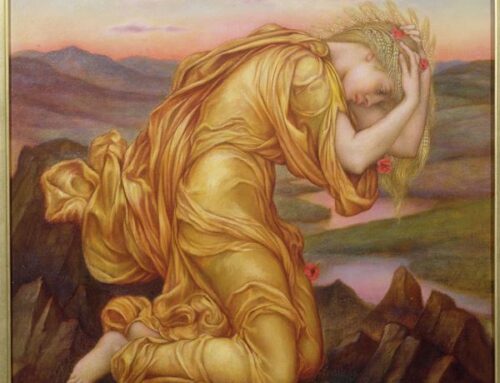In this blog Art History student Callista Aston from the University of Auckland explains how she helped the De Morgan Foundation to identify the source material for a study in our collection by Evelyn De Morgan: D_EDM_0390. The study is one of several copies which we believe Evelyn undertook in situ at various museums whilst training to be an artist. We’d like to thank Callista for her contribution to the ever increasing knowledge and understanding of the works in our collection.
“The art of Evelyn De Morgan has been a source of inspiration for me for many years, and is one of the reasons I chose to pursue a degree in Art History at the University of Auckland. During my studies I have developed a keen interest in areas of art conservation and research, but I never dreamed that I would have the opportunity to make my own contribution to art history research.

However, that changed recently when I saw a post on the De Morgan Foundation Facebook page asking for help in locating a source for a drawing by Evelyn De Morgan. Although I am not an experienced researcher or art historian, I saw this as an exciting and unique opportunity to do something that was both challenging and meaningful.
I began my research by examining the image through visual analysis, paying particular attention to the depiction of the figures and their style of dress, which appeared to be between the fifteenth and sixteenth century. I also considered the way the drapery was depicted, which suggested that the style was Flemish.
With a basic time frame and location, I turned my attention to exploring the narrative of the drawing, which became the most puzzling aspect of the search, specifically the figure of a noble woman brandishing a sword. I considered that she might represent the allegorical figure Justice, however, I was not able to prove this theory without additional symbolic evidence. Likewise, I excluded the biblical image of Judith, who is typically shown holding a severed head, along with a sword. In addition, I considered that it might represent a historical narrative of a noble woman with a fighting spirit. I considered various possibilities, such as Margaret of Anjou and Joanna of Flanders, yet I could not find evidence connecting anyone specifically with the scene in the drawing, so I reluctantly abandoned that area of research.
The next aspect of the drawing I looked at closely was the landscape, and the dense foliage within the picture space, which was very common in tapestries of the period. With this in mind, I felt confident that the source would be a tapestry so I began looking at images of Flemish tapestries from books, online image searches, databases and art collections. I searched through countless images of tapestries and noticed similar decorative motifs and compositions to the one seen in the drawing, but an exact match continued to allude me.
It became necessary to narrow my search, so I began to consider collections containing tapestries that might have been accessible to artists during the the nineteenth century. The extensive collections throughout London seemed to make the most logical sense, and it was at the Victoria and Albert Museum that I found a tapestry titled, La Main Chaude, which I considered to be the closest in style to the drawing, especially the male figure lying on the ground.Although it was not the work I was searching for, it inspired me to search further through the Royal Collections, and it is there in the collection at Hampton Court Palace where I came across a tapestry titled, The Redemption of Man, which immediately caught my eye with a familiar composition of figures in the left foreground. To my absolute delight I realised I had found the original source of Evelyn De Morgan’s drawing.

Royal Collection Trust/© Her Majesty Queen Elizabeth II 2015
Although it had taken many weeks of searching, my persistence finally paid off, and I was able to share this discovery with the De Morgan Foundation. I am incredibly grateful to the De Morgan foundation for providing such a rare opportunity to contribute to their research. It was an amazing experience that I will never forget.”
Callista Aston, January 2016
Below are links to the websites which contain more information about the two tapestries.






